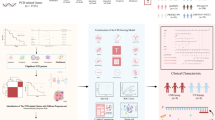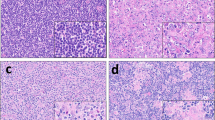Abstract
Purpose
Cutaneous angiosarcoma (CAS) is a rare but typically aggressive malignant vascular neoplasm of the skin. Tumor microenvironment (TME) of CAS and its associations with baseline clinicopathological features and patient outcomes are very important, especially when considering the recent advances in understanding of the tumor biology.
Methods/patients
We retrospectively reviewed medical records of patients who underwent surgical resection for CAS at a tertiary Hospital. The pretreated specimens were evaluated by immunohistochemistry for programmed cell death protein 1 (PD-1) and its ligand (PD-L1), densities of tumor infiltrative lymphocytes (TILs) (CD3+, CD4+, CD8+, CD45RO+, FoxP3+), as well as c-MYC and Ki-67 expressions. Overall survival (OS) was estimated by Kaplan–Meier method and compared with Log-rank test.
Results
A total of 21 CAS patients were identified. Median age was 67 (ranges: 20–81) years, 14 (66.7%) were male, and over 50% had lesions of scalp. Histopathological examination showed a predominantly spindle cell type (57.1%). All patients underwent surgery, 16 (76.2%) were treated further. PD-L1 was positively stained (> 1%) in tumor cells (42.9%) and TILs (23.8%). PD-1 expression (> 1%) was identified in TILs of 11 (52.4%) cases. PD-1/PD-L1 expressions were significantly associated with the higher densities of CD3+, CD4+, CD8+, CD45RO+, and Foxp3+ TILs, but not with patient characteristics or c-MYC or Ki-67 expression. Median OS was 18.5 months (95% CI 6.0–35.9), although no prognostic significance was observed with respect to any clinicopathological features.
Conclusion
We characterized TME and its clinical and prognostic association in CAS. PD-1/PD-L1 expressions were significantly associated with TILs subtypes but not with OS.


Similar content being viewed by others
References
Antonescu C. Malignant vascular tumors—an update. Modern Pathol. 2014;27:S30–8 (Suppl 1).
Dossett LA, Harrington M, Cruse CW, Gonzalez RJ. Cutaneous angiosarcoma. Curr Probl Cancer. 2015;39(4):258–63.
Bernstein JM, Irish JC, Brown DH, Goldstein D, Chung P, Razak ARA, et al. Survival outcomes for cutaneous angiosarcoma of the scalp versus face. Head Neck. 2017;39(6):1205–11.
Fujisawa Y, Yoshino K, Kadono T, Miyagawa T, Nakamura Y, Fujimoto M. Chemoradiotherapy with taxane is superior to conventional surgery and radiotherapy in the management of cutaneous angiosarcoma: a multicentre, retrospective study. Br J Dermatol. 2014;171(6):1493–500.
Perez MC, Padhya TA, Messina JL, Jackson RS, Gonzalez RJ, Bui MM, et al. Cutaneous angiosarcoma: a single-institution experience. Ann Surg Oncol. 2013;20(11):3391–7.
Florou V, Rosenberg AE, Wieder E, Komanduri KV, Kolonias D, Uduman M, et al. Angiosarcoma patients treated with immune checkpoint inhibitors: a case series of seven patients from a single institution. J Immunother Cancer. 2019;7(1):213.
Honda Y, Otsuka A, Ono S, Yamamoto Y, Seidel JA, Morita S, et al. Infiltration of PD-1-positive cells in combination with tumor site PD-L1 expression is a positive prognostic factor in cutaneous angiosarcoma. Oncoimmunology. 2017;6(1):e1253657.
Shimizu A, Kaira K, Okubo Y, Utsumi D, Yasuda M, Asao T, et al. Positive PD-L1 expression predicts worse outcome in cutaneous angiosarcoma. J Glob Oncol. 2017;3(4):360–9.
Kawamura A, Kawamura T, Riddell M, Hikita T, Yanagi T. Regulation of programmed cell death ligand 1 expression by atypical protein kinase C lambda/iota in cutaneous angiosarcoma. Cancer Sci. 2019;110(5):1780–9.
Bagaria SP, Gatalica Z, Maney T, Serie D, Parasramka M, Attia S, et al. Association between programmed death-ligand 1 expression and the vascular endothelial growth factor pathway in angiosarcoma. Front Oncol. 2018;8:71.
Botti G, Scognamiglio G, Marra L, Pizzolorusso A, Di Bonito M, De Cecio R, et al. Programmed death ligand 1 (PD-L1) expression in primary angiosarcoma. J Cancer. 2017;8(16):3166–72.
Fujii H, Arakawa A, Utsumi D, Sumiyoshi S, Yamamoto Y, Kitoh A, et al. CD8+ tumor-infiltrating lymphocytes at primary sites as a possible prognostic factor of cutaneous angiosarcoma. Int J Cancer. 2014;134(10):2393–402.
Gambichler T, Koim S, Wrobel M, Käfferlein HU, Brüning T, Stockfleth E, et al. Expression of programmed cell death proteins in Kaposi sarcoma and cutaneous angiosarcoma. J Immunother. 2020;43(5):169–74 (Hagerstown, Md: 1997).
Wollina U. Angiosarcoma: an immunogenic tumour. Br J Dermatol. 2018;179(2):257–8.
Zhang ZY, Cheng YJ, Gong XL, Ge YP, Bai CM, Wang XJ, et al. Characteristics and outcomes of primary angiosarcoma. Zhonghua zhong liu za zhi [Chin J Oncol]. 2019;41(9):693–7.
Wang L, Lao IW, Yu L, Wang J. Clinicopathological features and prognostic factors in angiosarcoma: a retrospective analysis of 200 patients from a single Chinese medical institute. Oncol Lett. 2017;14(5):5370–8.
Magara T, Nakamura M, Oda T, Kato H, Morita A. Dynamic change of PD-L1 expression in cutaneous angiosarcoma. J Investig Dermatol. 2019;139(9):S302.
Chang C, Wu SP, Hu K, Li Z, Schreiber D, Oliver J, et al. Patterns of care and survival of cutaneous angiosarcoma of the head and neck. Otolaryngology—Head Neck Surg. 2020;162(6):881–7.
Oashi K, Namikawa K, Tsutsumida A, Takahashi A, Itami J, Igaki H, et al. Surgery with curative intent is associated with prolonged survival in patients with cutaneous angiosarcoma of the scalp and face—a retrospective study of 38 untreated cases in the Japanese population. Eur J Surg Oncol. 2018;44(6):823–9.
Chow TL, Kwan WW, Kwan CK. Treatment of cutaneous angiosarcoma of the scalp and face in Chinese patients: local experience at a regional hospital in Hong Kong. Hong Kong Med J Xianggang yi xue za zhi. 2018;24(1):25–31.
Googe PB, Flores K, Jenkins F, Merritt B, Moschos SJ, Grilley-Olson JE. Immune checkpoint markers in superficial angiosarcomas: PD-L1, PD-1, CD8, LAG-3, and tumor-infiltrating lymphocytes. Am J Dermatopathol. 2020;43(8):556–559.
Orth MF, Buecklein VL, Kampmann E, Subklewe M, Noessner E, Cidre-Aranaz F, et al. A comparative view on the expression patterns of PD-L1 and PD-1 in soft tissue sarcomas. Cancer Immunol Immunother. 2020;69(7):1353–62.
Patel SH, Hayden RE, Hinni ML, Wong WW, Foote RL, Milani S, et al. Angiosarcoma of the scalp and face: the Mayo Clinic experience. JAMA Otolaryngol Head Neck Surg. 2015;141(4):335–40.
Buehler D, Rice SR, Moody JS, Rush P, Hafez GR, Attia S, et al. Angiosarcoma outcomes and prognostic factors: a 25-year single institution experience. Am J Clin Oncol. 2014;37(5):473–9.
Cassidy RJ, Switchenko JM, Yushak ML, Madden N, Khan MK, Monson DK, et al. The importance of surgery in scalp angiosarcomas. Surg Oncol. 2018;27(4):A3-a8.
Weidema ME, Flucke UE, Ho VKY, Hillebrandt-Roeffen MHS, Desar IME. Prognostic factors in a large nationwide cohort of histologically confirmed primary and secondary angiosarcomas. Cancers. 2019;11(11):1780.
Sinnamon AJ, Neuwirth MG, Mcmillan MT, Ecker BL, Karakousis GC. A prognostic model for resectable soft tissue and cutaneous angiosarcoma. J Surg Oncol. 2016;114(5):557–563.
Espejo-Freire AP, Elliott A, Rosenberg A, Costa PA, Barreto-Coelho P, Jonczak E, et al. Genomic landscape of angiosarcoma: a targeted and immunotherapy biomarker analysis. Cancers (Basel). 2021;13(19):4816.
Sindhu S, Gimber LH, Cranmer L, McBride A, Kraft AS. Angiosarcoma treated successfully with anti-PD-1 therapy—a case report. J Immunother Cancer. 2017;5(1):58.
Xu F, Zheng J, Fu M, Zhou H. Antiprogrammed cell death protein 1 immunotherapy for angiosarcoma with high programmed death-ligand 1 expression: a case report. Immunotherapy. 2020;12(11):771–6.
Campanella NC, Penna V, Ribeiro G, Abrahão-Machado LF, Scapulatempo-Neto C, Reis RM. Absence of Microsatellite Instability In Soft Tissue Sarcomas. Pathobiology. 2015;82(1):36–42.
Casey SC, Tong L, Li Y, Do R, Walz S, Fitzgerald KN, et al. MYC regulates the antitumor immune response through CD47 and PD-L1. Science. 2016;352(6282):227–31.
Fraga-Guedes C, André S, Mastropasqua MG, Botteri E, Toesca A, Rocha RM, et al. Angiosarcoma and atypical vascular lesions of the breast: diagnostic and prognostic role of MYC gene amplification and protein expression. Breast Cancer Res Treat. 2015;151(1):131–40.
Requena C, Rubio L, Lavernia J, Machado I, Llombart B, Sanmartín O, et al. Immunohistochemical and fluorescence In situ hybridization analysis of MYC in a series of 17 cutaneous angiosarcomas: a single-center study. Am J Dermatopathol. 2018;40(5):349–54.
Manner J, Radlwimmer B, Hohenberger P, Mössinger K, Küffer S, Sauer C, et al. MYC high level gene amplification is a distinctive feature of angiosarcomas after irradiation or chronic lymphedema. Am J Pathol. 2010;176(1):34–9.
Mentzel T, Schildhaus HU, Palmedo G, Büttner R, Kutzner H. Postradiation cutaneous angiosarcoma after treatment of breast carcinoma is characterized by MYC amplification in contrast to atypical vascular lesions after radiotherapy and control cases: clinicopathological, immunohistochemical and molecular analysis of 66 cases. Modern Pathol. 2012;25(1):75–85.
Shon W, Sukov WR, Jenkins SM, Folpe AL. MYC amplification and overexpression in primary cutaneous angiosarcoma: a fluorescence in-situ hybridization and immunohistochemical study. Modern Pathol. 2014;27(4):509–15.
Donghi D, Kerl K, Dummer R, Schoenewolf N, Cozzio A. Cutaneous angiosarcoma: own experience over 13 years. Clinical features, disease course and immunohistochemical profile. J Eur Acad Dermatol Venereol. 2010;24(10):1230–4.
Kaira K, Shimizu A, Yasuda M, Ohkubo Y, Ishikawa O. PD-L1 expression and possibility of its therapeutic target in cutaneous angiosarcoma. J Clin Oncol. 2016;34:e23110-e (15_suppl).
Adam J, Le Stang N, Rouquette I, Cazes A, Badoual C, Pinot-Roussel H, et al. Multicenter harmonization study for PD-L1 IHC testing in non-small-cell lung cancer. Ann Oncol. 2018;29(4):953–8.
Hirsch FR, McElhinny A, Stanforth D, Ranger-Moore J, Jansson M, Kulangara K, et al. PD-L1 immunohistochemistry assays for lung cancer: results from phase 1 of the blueprint PD-L1 IHC assay comparison project. J Thorac Oncol. 2017;12(2):208–22.
Author information
Authors and Affiliations
Corresponding authors
Ethics declarations
Conflict of interest
The authors declare that they have no conflicts of interest.
Ethical approval
The study was reviewed and approved by institutional ethics committees.
Informed consent
Informed consent was waived for this retrospective study.
Additional information
Publisher's Note
Springer Nature remains neutral with regard to jurisdictional claims in published maps and institutional affiliations.
Supplementary Information
Below is the link to the electronic supplementary material.
Rights and permissions
About this article
Cite this article
Bi, Y., Ge, L., Ren, X. et al. Tumor microenvironment and its clinicopathological and prognostic associations in surgically resected cutaneous angiosarcoma. Clin Transl Oncol 24, 941–949 (2022). https://doi.org/10.1007/s12094-021-02744-0
Received:
Accepted:
Published:
Issue Date:
DOI: https://doi.org/10.1007/s12094-021-02744-0




